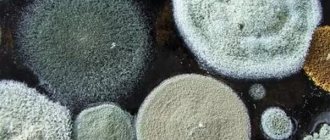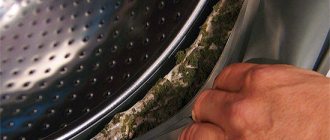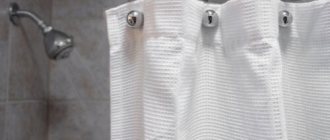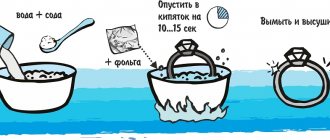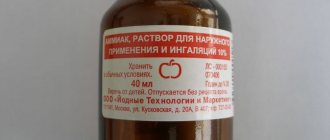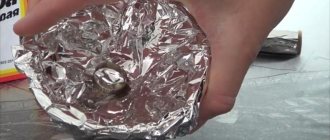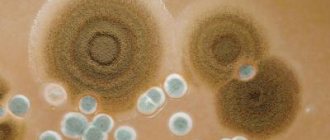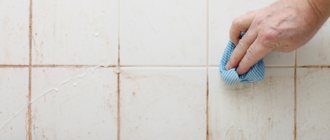High indoor humidity and hot steam, which increases the air temperature, are the main factors affecting the microclimate. If ventilation is impaired or not provided, the process of reproduction of pathogenic particles, including fungal spores, is activated. When choosing a way to get rid of mold in the bathroom, consider home remedies because they are gentle on walls and floors. If traditional methods do not help, deep penetration chemicals are used.
Hot steam affects the microclimate of the room.
Why is mold on walls dangerous?
Mold is a colony of single-celled fungus that reproduces by spores. These microscopic spores are present in the air almost everywhere, as they are transported along with dust masses.
Bathroom ceiling covered in mold.
If the situation in the house is favorable, mold has not found a “place to settle,” then the human body does not even notice these spores in small quantities (except for people with allergies). It’s a different matter if the colony settled, began to grow, and itself turned into a constantly operating “generator” of these same spores. Then they inevitably enter the indoor air in large quantities and contribute to the rapid further development of colonies. But they begin to pose a particular danger when they enter the human body, causing a number of dangerous diseases.
- Allergic reactions are very severe and extend even to those people who were not previously affected by other allergens.
- Respiratory tract diseases. With constant inhalation of spores, a person can develop even such serious diseases as pneumonia and asthma, with the transition to a difficult-to-treat chronic stage.
- Skin diseases - dermatoses, mycoses and other lesions.
- A state of exhaustion of the body, disorders of the digestive system, nausea, dizziness and headaches are possible.
- When exposed to mold, very serious systemic disturbances in the functioning of the lungs, liver, kidneys and other organs can occur.
Fungal infections are especially dangerous for the elderly, children, and those who are already predisposed to allergic reactions. Medical statistics know many cases with fatal outcomes.
Fungal infections also cause serious damage to building structures. This should also never be forgotten. The longer the fight against this pathogenic microflora is “postponed until later,” the more difficult it will be to cope with it in the future.
Mold that appears on the surface of walls and ceilings gradually grows inside and destroys the structure of building materials. This leads to peeling of the plaster and decorative cladding.
Mold that has penetrated the structure of concrete slabs draws out the lime components from them, which dramatically increases the fragility of the material. In addition, as a result of the vital activity of the fungus, decay products are formed, resulting in internal stress. If timely measures are not taken, destruction of the surface layers of slabs or masonry may occur. Then considerable costs will be required not only for removing mold, but also for repairing walls and ceilings.
Wood that is not properly treated becomes extremely vulnerable to fungal attack.
Well, mold is completely destructive for wooden parts - it can “eat up” high-quality wood in just a couple of years. Fortunately, if we are talking only about finishing. But load-bearing parts can also be affected!
Why does mold appear?
Fungus appears in the bathroom for the following reasons:
- Poor ventilation. Even a constantly closed bathroom door will not cause mold if there is good draft in the exhaust duct.
- Low temperature or changes. When moisture does not dry out, ideal conditions are created for spores to develop.
- Condensation on pipes. Most often found on cast iron.
- Leak. Leaking pipes, faucets or toilets are one of the main causes of mold.
The photo shows what fungus looks like in the bathroom
It also happens that there is no reason for the formation of mold, but it appeared in one single place - perhaps this was due to a leak in the mine. In this case, contact the management company.
Causes of fungus
As was said at the beginning of the article, the main condition for the development of fungus is a high level of humidity, and not just high, but exceeding 70-80%. The ideal microclimate for the occurrence of fungus occurs at a humidity level of 90-95%. Insufficient ventilation in the bathroom also plays a significant role in the formation of mold.
The next factor favoring mold fungus is insufficient waterproofing of the room. If the bathroom is often hot (more than 20 degrees Celsius), the appearance of fungus is only a matter of time.
When suitable conditions arise, spores, connecting with a moist surface, begin to grow rapidly, creating colonies. If nothing is done, small black, green or brown spots of mold gradually grow and occupy larger and larger areas. In this case, the spores not only grow in width, but also penetrate into the material with thin threads.
Fungus can affect both the walls and floor of the bathroom. Typically, mold forms primarily on the seams between tiles.
Mechanical method of removing fungus
One of the tools you will need to remove fungus mechanically is a spatula.
When black spots appear on the sealant in the joints between tiles in the bathroom or on the walls in living areas, the affected coating must first be removed. Different tools are used for this:
- putty knife;
- steel brush;
- grinding attachment (installed on the drill);
- sharp knife, etc.
To prevent the spread of spores through the air (the main method of contamination of surfaces), the cladding must be treated with water. To do this, it is recommended to use a spray bottle. If you use a sponge or rag, some of the spores will become airborne when the material comes into contact with the surface. When the fungus has already penetrated the structure of wood or concrete, the milling method is used. When the infection is severe, mold is also found on inorganic surfaces. If you plan to fight it yourself, it is important to follow the instructions:
- The surface is moistened with water from a spray bottle.
- They free load-bearing structures from cladding: wallpaper on the walls, whitewash on the ceiling, flooring. This will allow you to get to the mycelium.
- If it turns out that the mold has penetrated deeper into the structure of the material of the supporting structure, remove the layer of plaster. It is necessary to clean the wall down to the rough base - brickwork, concrete.
At the next stage, chemicals are used. However, if the preparatory work (mechanical cleaning) did not provide the required result, special means will not destroy the fungus. It will continue to develop on the adjacent site.
Chemical agents can also be used against fungus.
Folk remedies against mold
Before the advent of special preparations, home methods were used to remove dark spots from surfaces. Some of them remove mold well, which is why they are still used today. However, in terms of effectiveness, they do not always correspond to ready-made drugs. This is partly due to the fact that they use products that have a simple composition (contain 1 component).
To achieve the required result, in most cases it is recommended to apply the substances several times: from 2 to 5. A single treatment does not help destroy pathogenic particles.
Hydrogen peroxide
Hydrogen peroxide against fungus in the bathroom.
A 3% solution is used, it can be purchased at a pharmacy. The advantages of this tool:
- ease of use;
- no odor;
- the substance leaves no traces;
- peroxide can be applied to coatings made of different materials; it does not destroy their structure, but a weak bleaching effect appears on colored surfaces.
To clean mold, you do not need to dilute the substance with water. Instructions for use:
- The product is applied to the surface where the fungus develops. Moreover, the area of this zone should be larger than the affected area.
- We need to vacate the premises for a few hours. If the lesion is weak, 15-60 minutes is enough. During this period of time the premises cannot be used.
- After a few hours, you can ventilate the room, then remove the mold using a stiff brush.
Boric acid
To clean fungus from surfaces at home, prepare a solution: 1 cup of the drug, 2 liters of water. In this case, it is recommended to first remove external manifestations of mold. The surface is first moistened with water to prevent spores from spreading through the air. Once the dark spots have been removed, a boric acid solution can be applied. To do this, use a rag or a soft sponge.
Using boric acid against fungus in the bathroom.
The product is left on the surface. After it dries, the remaining powder and emerging crystals are cleaned off with paper or another sponge. In this case, you cannot use materials that were used to remove the fungus from the surface, because in this case, infection will occur again.
It is permissible to use a less concentrated solution: 4 liters of water, 1 glass of boric acid. It is used to treat surfaces by spraying with a spray bottle. Borax can be used instead of boric acid. These are different substances that exhibit similar properties. Both are antiseptics, but borax is less effective.
Tea tree oil
Tea tree oil for fungus in the bathroom.
This product helps remove fungus, since microorganisms are sensitive to the components that make up it. It is necessary to prepare a solution: 1 tsp. essential oil, 500 ml water. The substance is sprayed over the affected surface, then the dark coating is removed.
The duration of action of the product is 12 hours. Moreover, you cannot be indoors at this time. There is no need to rinse it off after the solution has finished working.
The aroma will remain in the room for some time. In case of intensive infection, prepare a more concentrated solution: 20 ml of essential oil, 1 liter of water.
Soda and vinegar
You can use soda ash and baking soda. If mold appears on tiles and other surfaces that can withstand exposure to aggressive substances, it is recommended to prepare a solution:
- Heat water (5 l).
- Add 150 g of soda of any kind. Moreover, the desired chemical reaction will occur provided that the components are diluted with hot water.
- Vinegar essence (9% concentration) - 100 g is poured into the resulting solution.
Killing fungus in the bathroom with baking soda and vinegar.
When mixing the components, foam is formed. After obtaining the desired chemical reaction, you can apply the product to the affected surfaces. To destroy fungus that has spread extensively along the wall/ceiling or floor, you need to carry out repairs - this is a radical method, but thanks to it mold is destroyed forever. First, remove the plaster, then sprinkle the area with soda and spray with concentrated vinegar.
Aqueous ammonia
This product can be applied to surfaces that do not have porosity, such as the joints of ceramic tiles in the bathroom. To improve the properties of aqueous ammonia, glycerin is added. Apply the substance using a rag or sponge. Care must be taken when doing this, as aqueous ammonia is toxic. After treatment, you need to leave the room for 1 hour. Then the remaining product is washed off from the surfaces.
Copper sulfate
The best way. It is distinguished by a significant impact on pathogenic particles. Prepare a solution using 100 g of copper sulfate (copper sulfate), 10 liters of water. If the affected area is small, the number of components is proportionally reduced. Use a brush for application. It is recommended to treat an area ¼ or 1/3 larger than the area where the fungus is developing. After a few hours, ventilate the room, wash off the solution, and along with it the fungus.
The effectiveness of using copper sulfate against fungus.
Chlorine bleach
Any product containing chlorine can be used. To destroy the fungus, Belizna and Domestos are suitable. A concentrated product is applied to the affected areas. A rag is used for this. Cleaning silicone (tile joints) is carried out with an aqueous solution based on a chlorine-containing agent. The ratio of components is 1:1. Use a spray bottle for spraying.
Household chemicals
Designed to effectively remove fungus, household chemicals can clean contaminated surfaces several times faster than any folk remedy.
If you are not allergic to the components of antifungal drugs and there are no pets in your apartment, then feel free to use special anti-mold chemicals.
"Belizna" - chlorine-based solution
The most famous and inexpensive product called “Whiteness” for 50 rubles. Excellent removes mold stains from various surfaces.
Spraying a bleach solution onto a whitewashed ceiling will remove mold stains and stop mold growth.
To prepare the solution:
- Bleach is diluted with water in a ratio of 1 to 10.
- Apply it to a cleaned surface and wait for it to dry.
The disadvantage of this product is the specific smell of chlorine.
Oxygen bleach
It is based on sodium percarbonate , which can cope with different types of mold.
This product is well suited for removing stains from colored surfaces. With its help, you can remove fungus from curtains in the bathroom, remove black stains from tile joints, curtains, etc.
There is a large selection of such bleaches on sale. The most famous:
- "Bos Plus" costs about 30 rubles;
- “Sano Oxygen”, it can be bought for 280-300 rubles;
- “Vanish Gold” for 140-150 rubles.
Special antifungal
They are distinguished by their speed of action and efficiency . Thanks to it you can clean:
- plumbing;
- shower cabin;
- tiles
Cleaning surfaces will take from 10 minutes to an hour . Example:
- “Cillit Bang”, price 150-170 rubles;
- spray “Unicum”, costing about 180 rubles;
- “Turbo”, priced at 300-350 rubles.
Regular white vinegar is an effective remedy for fungus.
The use of vinegar is very convenient because zealous housewives always have it in their household, since they add vinegar to some dishes, and also use it to clean the apartment. Due to its naturalness, vinegar is safe for health, despite the fact that the bathroom will be filled with a specific smell after its use. However, the smell does not last long - it quickly dissipates.
To remove mold with vinegar, you must follow these steps:
- Pour the vinegar solution into a spray bottle or soak a cloth in it.
- Apply to areas where mold has appeared and allow the mixture to dry.
- Clean surfaces with a stiff brush.
- Rinse areas treated with vinegar with clean water.
Using ordinary vinegar, about 80% of different types of fungi are destroyed - this is an effective weapon against mold.
Of the different types of vinegar that exist, to use in the fight against mold is one that is suitable for cleaning an apartment - simple white vinegar, which does not contain aromatic additives or herbs.
Products used for repair work
To avoid mold contamination of walls for a long time, builders use highly effective fungal repellents.
Copper sulfate and special primers or emulsions applied to the wall will not only completely destroy the fungus that appeared before the repair, but will also prevent its reproduction in the future.
Let's take a closer look at how these tools work:
How to remove mold stains with copper sulfate?
This is one of the most effective remedies for fungus. Copper sulfate, which can be bought for 150 rubles, can protect walls from mold for a long time.
To treat surfaces, dilute the following solution:
- take 100 gr. vitriol;
- 10 liters of water.
Apply the product to the wall with a brush . In places where the fungal infection is very strong, the wall is covered with a solution in several layers.
When 3-4 hours have passed, the wall is washed and dried.
Copper sulfate must be handled very carefully because this product is very toxic. When working with it, you need to ventilate the room well, and also use a respirator and gloves.
Antiseptic emulsions
These drugs include antifungicides that protect against biocorrosion. They are made on the basis of QAC (quaternary ammonium compounds) and guanide.
For the bathroom, Renogal is suitable for 360 rubles, which can remove mold even from the seams between the tiles.
The following tools are also popular among users:
- antiseptic “Abedis 06 Barwa Sam” for 250-300 rubles;
- “Snowball Puma” for 80-100 rubles;
- emulsion “Alpina Ground” for 300-350 rubles.
Primers
Before using these products, you need to prepare the surfaces. A layer of whitewash or paint is removed from the walls and ceiling, and the plaster is dried using a hair dryer.
You need to work in a respirator so that mold pores do not enter the respiratory tract.
The finished walls and ceiling are treated with an antifungal emulsion or other product.
Among the popular means:
- “Ceresit CT-99” antifungal primer costing 360-400 rubles;
- primer "Caparol Capatox" for 650-700 rubles;
- "Bairis BioStop" for 200-250 rubles.
Procedure for removing mold
The choice of strategy for combating mold largely depends on the depth of fungal damage to surfaces. The larger the area of infection, the more difficult it is to combat the problem. Conventionally, the entire process can be divided into the preparation and processing stage.
Preparation stage
The preparatory stage consists of removing the top layer affected by the fungus, and if this is not done, mold will soon appear in the same place again. Working with walls covered with wallpaper or painted is much easier than with those on which tiles are laid. Depending on the type of surface, the following measures can be applied:
- Tile. The main affected area is the seams filled with cement grout, or the junction of the tiles with the plumbing, which are filled with sealant. To get rid of the fungus forever, you need to carry out the following actions: jointing - an event to remove colored filler from the tile joints. This procedure can be carried out using a special tool that resembles a grinder (grinder). Mechanical tools are also used, for example, a screwdriver, chisel, dental instrument,
- drying - removing moisture and microscopic spores from the seams using a thermal method. For this you can use an autogen, a hair dryer, a blowtorch,
- knocking - if the fungus has affected not only the seams between the tiles, but also covers the tiles on top, there is a high probability that mold spores are deep in the wall. In this case, you will have to knock down the cladding, tile adhesive, plaster, removing all affected layers,
- Remove wallpaper - remove sheets damaged by fungus from the walls.
- Mechanical cleaning - the surface is cleaned using a damp cloth and a hard sponge.
Processing stage
Treating walls against mold involves applying special disinfectant compounds to a surface that has been damaged by fungus. It is necessary to carry out the treatment only after the wall or ceiling has been cleaned and completely dried. This procedure can be carried out using professional (store-bought) or folk remedies. Processing involves two key tasks:
- disinfection - the use of highly alkaline or caustic acidic substances to destroy residual fungal spores,
- protection - creating an environment in which mold cannot grow in the future.
Depending on the area of the damaged plane and the shape of the product, the following tools can be used:
- brush for applying the composition to the wall,
- roller for processing horizontal surfaces (floors and ceilings),
- container for disinfectant composition,
- spray bottle for spraying products onto walls,
- compressor sprayer for treating large areas.
The bathroom mold treatment process may look like this:
- Apply anti-fungal agent to a clean and dry surface in any convenient way.
- Drying the treated surface naturally to ensure complete drying of the composition.
- Removing loose or granular preparations using a hard sponge or dry cloth.
- Ventilate the room, treat the walls with an ultraviolet lamp for several hours.
Safety precautions
At the preparatory stage and during the process of treating walls with special means, it is necessary to follow safety regulations. To do this, use personal protective equipment:
- respirator,
- latex gloves,
- protective glasses that fit tightly to the face,
- clothing that completely covers arms and legs.
At the preparation stage, safety precautions ensure protection of the respiratory organs and mucous membranes from the ingress of fungal spores and particles of building materials, and during processing they protect the respiratory organs and mucous membranes from chemical vapors, and also protect the skin from chemical burns from aggressive acids and alkalis.
Getting rid of mold using specialized products
In the assortment of specialized stores, it is easy to choose antiseptic compositions aimed at combating fungus in the bathroom:
- The “Antifungal-Anti-Mold” product presented can be used to treat surfaces as a primer during repairs. And they also add it to whitewash or water-based paints. If you are deciding how to remove fungus in the bathroom without dismantling the finish, then you should treat all stains with a brush or roller.
- Antiseptics from the “Isocide” series of the Ukrepservice enterprise allow you to fight mold on various materials, destroying other harmful microorganisms that can be found in the bath.
- It is important to know how to remove fungus in the bathroom using means that are safe for health. For example, latex emulsion “MIL KILL”, produced by. It is often used during repairs as a preventive primer, although if necessary, you can use it to clean any hard-to-reach places where dark spots are noticed.
- Allows you to get rid of black mold in the bathroom with the universal antiseptic “DALI”, offered by JSC NPP Rogneda, sold in finished form.
Many people, faced with the problem of how to destroy fungus, turn to time-tested solutions. An example is copper sulfate (100 g of powder is diluted in 10 liters of water). Apply it to all surfaces, after wearing gloves and a respirator. Then the areas with obvious mold infestation are coated again. After 7–8 hours, the treated surface is washed, dried, and the room is ventilated.
Another well-known composition for removing black mold in the bathroom is chlorine bleach, which is added to water in a ratio of 1:10. When working, you need a respirator and rubber gloves. If you get rid of fungus in this way, then there is no need to wash off the applied product, but the room should be thoroughly ventilated.
Armed with the knowledge of how to remove mold in the bathroom, it is advisable to use the preparation “Renogal” (Germany) to treat the seams, which will preserve the lining. If fungal colonies are removed with a solution of bleach or copper sulfate, then after washing them off, the joints are coated with a sealant.
Before you fight to keep surfaces free from fungus and make a purchase, you need to study information about antiseptics in order to choose the variety that is suitable for your specific conditions.
Will repairs help?
Seeing dark spots, some people decide to carry out repairs by replacing damaged materials. It is worth considering that simply painting or plastering the surface will only solve the problem for a short time. Spores, through which the microorganism reproduces, can hide under any finishing material.
New repairs are recommended only if measures are taken to change the microclimate in the room. In this case, work must be carried out exclusively using protective equipment.
Preventing mold in the bathroom
Prevention prevents the reappearance of fungus indoors. Important:
- Find out the correct location of the ventilation ducts. If necessary, call a specialist. He will conduct a professional inspection and report on the operation of the ventilation.
- After using the shower or bath, wipe the walls with a towel, removing excess moisture. Leave the door open.
- Be sure to use the kitchen hood when cooking or boiling water.
- Avoid growing indoor plants: geraniums, violets. They cause mold.
- When repairing walls, use a primer treatment. It prevents the appearance and spread of fungus.
- Insulate the walls in the apartment. Especially on the north side. You can use special impregnation during work.
- If cracks appear in the walls, they must be sealed. Carefully check the baseboards for drafts. Frequent temperature changes in the apartment are not allowed.
- Buy devices that absorb moisture. Place on all windowsills.
When fungus appears on the walls, tiles, bathrooms, or under the sink, it is important to do some work.
There are many types of mold, but if you eliminate it in time, there will be no consequences. Fungus is removed using chemical and folk remedies.
No antifungal grout will help if there are suitable conditions for the formation of fungus and mold
In advanced cases, the affected areas are often replaced. Chemicals will not help if the fungus is deeply embedded. Prevention is necessary. Then the mold will not affect the apartment premises.
